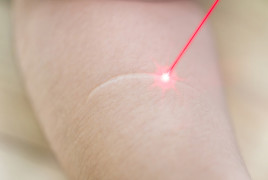Prurigo nodularis: Causes
What causes prurigo nodularis?
Dermatologists and other researchers are still studying what causes this disease.
From what researchers have found, we know that the following play a role in causing prurigo nodularis:
Nerves become more sensitive and overreact: This contributes to the itchy skin and inflammation (response in your body that harms healthy tissue).
An overly active immune system: When a person’s immune system overreacts, this also leads to inflammation. The increased inflammation contributes to the intensely itchy skin.
Who gets prurigo nodularis?
About half the people who develop prurigo nodularis have (or had) eczema/atopic dermatitis. Eczema is a common skin condition that often begins in childhood. It causes itchy, dry, and inflamed skin.

People around the world develop prurigo nodularis. While studying this disease, researchers have learned that some people have a higher risk of developing it.
It is more common in people who are:
50 years of age or older, usually between 51 and 65 years of age
Living with certain long-term diseases, including:
A skin disease that is often itchy, such as eczema/atopic dermatitis, contact dermatitis, cutaneous T-cell lymphoma, or lichen planus. About half of people who develop prurigo nodularis have (or had) eczema.
Diabetes
End-stage kidney disease
Hepatitis C
HIV (untreated)
Lymphoma (Hodgkin’s lymphoma or non-Hodgkin’s lymphoma)
Mental health conditions, including anxiety or depression
Taking certain medications, such as an antimalarial or opioid.
Receiving certain cancer medications. These include some chemotherapy medications and a few medications called immune checkpoint inhibitors, specifically pembrolizumab or nivolumab.
In the United States, Black people may be more likely than white people to develop prurigo nodularis. This finding comes from a study conducted at Johns Hopkins Hospital.
While some people have a higher risk of getting prurigo nodularis, it’s important to know that anyone can develop this disease.
If you have itchy bumps on your skin that last for more than 2 weeks, see a dermatologist. Should those itchy bumps turn out to be prurigo nodularis, early diagnosis and treatment can relieve the itch and clear the bumps.
When the itchy bumps could be a sign that you have another disease like one of those listed above, your dermatologist can treat the skin condition and help you get the care you need for other conditions.
To find out how dermatologists diagnose and treat prurigo nodularis, go to: Prurigo nodularis: Diagnosis and treatment.
Image
Getty Images
References
Boozalis E, Tang O, et al. “Ethnic differences and comorbidities of 909 prurigo nodularis patients.” J Am Acad Dermatol. 2018;79(4):714-9.
Elmariah S, Kim B, et al. “Practical approaches for diagnosis and management of prurigo nodularis: United States expert panel consensus.” J Am Acad Dermatol. 2021;84(3):747-60.
Huang AH, Williams KA, et al. “Prurigo nodularis: Epidemiology and clinical features.” J Am Acad Dermatol. 2020;83(6):1559-65.
Legat FJ, Weisshaar E, et al. “Pruritus and dysesthesia.” In: Bolognia JL, et al. Dermatology. (4th edition). Mosby Elsevier, China, 2018: 115-6.
Leis M, Fleming P, et al. “Prurigo nodularis: Review and emerging treatments.” Skin Therapy Lett. 2021;26(3):5-8.
Liao V, Cornman HL, et al. “Prurigo nodularis: New insights into pathogenesis and novel therapeutics.” Br J Dermatol. 2024 May 17;190(6):798-810.
Mullins TB, Sharma P, et al. “Prurigo nodularis. [Updated 2024 Mar 1]. In: StatPearls [Internet]. Treasure Island (FL): StatPearls Publishing.
Qureshi AA, Abate LE, et al. “A systematic review of evidence-based treatments for prurigo nodularis.” J Am Acad Dermatol. 2019;80(3):756-64.
Watsky K (author), Fowler J (section editor). “Prurigo nodularis.” UpToDate. Last updated August 21, 2024. Last accessed January 15, 2025.
Whang KA, Le TK, et al. “Health-related quality of life and economic burden of prurigo nodularis.” J Am Acad Dermatol. 2021;28:S0190-9622(21)01028-8.
Williams KA, Huang AH, et al. “Prurigo nodularis: Pathogenesis and management.” J Am Acad Dermatol. 2020;83(6):1567-75.
Written by:
Paula Ludmann, MS
Reviewed by:
Brendan Camp, MD, FAAD
Raj Chovatiya, MD, PhD, FAAD
Brian Kim, MD, FAAD
Ata Moshiri, MD, FAAD
Carla Torres-Zegarra, MD, FAAD
Last updated: 4/1/25
 Atopic dermatitis: More FDA-approved treatments
Atopic dermatitis: More FDA-approved treatments
 Biosimilars: 14 FAQs
Biosimilars: 14 FAQs
 How to trim your nails
How to trim your nails
 Relieve uncontrollably itchy skin
Relieve uncontrollably itchy skin
 Fade dark spots
Fade dark spots
 Untreatable razor bumps or acne?
Untreatable razor bumps or acne?
 Tattoo removal
Tattoo removal
 Scar treatment
Scar treatment
 Free materials to help raise skin cancer awareness
Free materials to help raise skin cancer awareness
 Dermatologist-approved lesson plans, activities you can use
Dermatologist-approved lesson plans, activities you can use
 Find a Dermatologist
Find a Dermatologist
 What is a dermatologist?
What is a dermatologist?